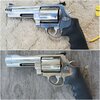A quick Google search produced this information:
https://www.ammoland.com/2014/05/smith-wesson-460xvr-revolver/#axzz6faCHAyxn
To help combat the recoil Smith & Wesson manufactured a very effective compensator into the 8.38” barrel with six ports placed at the muzzle beneath the fiber optic sight. Along with these two removable compensators that work in conjunction with these ports, recoil now generates a firm push instead of intense barrel rise like most revolvers. The first removable compensator consists of 12 slots that works in conjunction with the six existing ports on the barrel and is for use with jacketed bullet.
The second removable compensator extends from the barrel a ¼ inch and has nine holes but does not use the six smaller ports on the barrel. The second compensator is mainly designed for use with lead bullet ammunition. Why two separate compensators? Lead bullets generate more debris and the larger openings in the compensator allow lead particles to escape without clogging the compensator. Softer lead bullets driven at higher velocities can lead the inside of the barrel and particles may break loose. Bullet manufactures fix this problem by using lead bullets that have a higher content of tin and antimony making them harder (
known as solids or Hard Cast) and will help with this problem. These bullets can be driven harder (
fired at a higher velocity) than softer lead bullets without leading becoming an issue. Some lead bullets employ a gas check (
a copper cup on the base of the bullet) to aid in reducing leading of the bore and can be driven faster than they normally would



